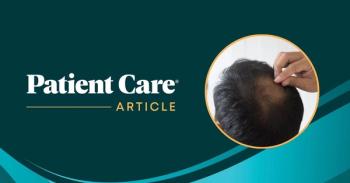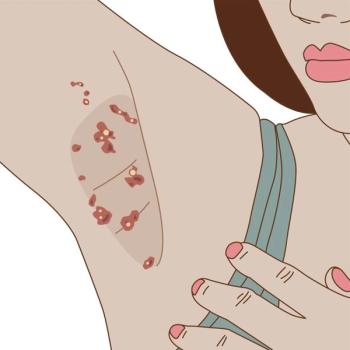
Perifolliculitis Abscedens Et Suffodiens
For about 10 years, a 26-year-old man had recurring cystic lesions on his scalp that would periodically enlarge, shrink, and occasionally drain. One lesion had been excised by another physician, but it later recurred. The patient had been taking minocycline (100 mg) daily for this condition.
For about 10 years, a 26-year-old man had recurring cystic lesions on his scalp that would periodically enlarge, shrink, and occasionally drain. One lesion had been excised by another physician, but it later recurred. The patient had been taking minocycline (100 mg) daily for this condition.
Examination revealed a soft, fluctuant, nontender, nonerythematous subcutaneous swelling on the left parietal scalp (A) and a larger, linear lesion on the right parietal scalp (B). The patient’s shoulders, back, and chest were normal.
The clinical diagnosis was perifolliculitis abscedens et suffodiens. This recurrent condition is characterized by discrete nodules and the formation of intercommunicating sinuses, with resultant scarring and alopecia. Patients may have frequent seropurulent drainage. The nodules often become infected with Staphylococcus aureus and hemolytic Streptomyces albus.
This type of perifolliculitis typically occurs in men in the second to fourth decade of life. The follicular, erythematous papules and cysts are generally found on the vertex and occiput. It is theorized that a foreignbody reaction causes follicular blockage that leads to a neutrophilic and granulomatous reaction. The differential diagnosis includes acne keloidalis nuchae, pseudopelade, and tinea capitis.1
Perifolliculitis is difficult to treat. X-ray epilation is usually avoided because of the potential adverse effects, such as skin atrophy, telangectases, and skin cancer. Laser hair removal has resulted in mild improvement. Some surgeons recommend removal of most of the scalp and application of skin grafts, although this involves a lengthy recovery. Incision and drainage of the sinuses, with cauterization of the base to destroy the epithelium lining, has also been used.
A 6-month regimen of oral isotretinoin (0.5 to 1.5 mg/kg/d) may be considered; however, because of its strict prescribing guidelines, many physicians prefer intralesional corticosteroids. Oral antibiotics can be used to treat secondary bacterial infections.
The size and recurrence of this patient’s lesions have been kept under control with long-term antibiotic treatment and intralesional triamcinolone injections.
References:
REFERENCE:
1
. Odom RB, James WD, Berger TG, eds.
Andrews’ Diseases of the Skin: Clinical Dermatology.
9th ed. Philadelphia: WB Saunders Co; 2000:300-301.
Newsletter
Enhance your clinical practice with the Patient Care newsletter, offering the latest evidence-based guidelines, diagnostic insights, and treatment strategies for primary care physicians.

















































































































































































































































































